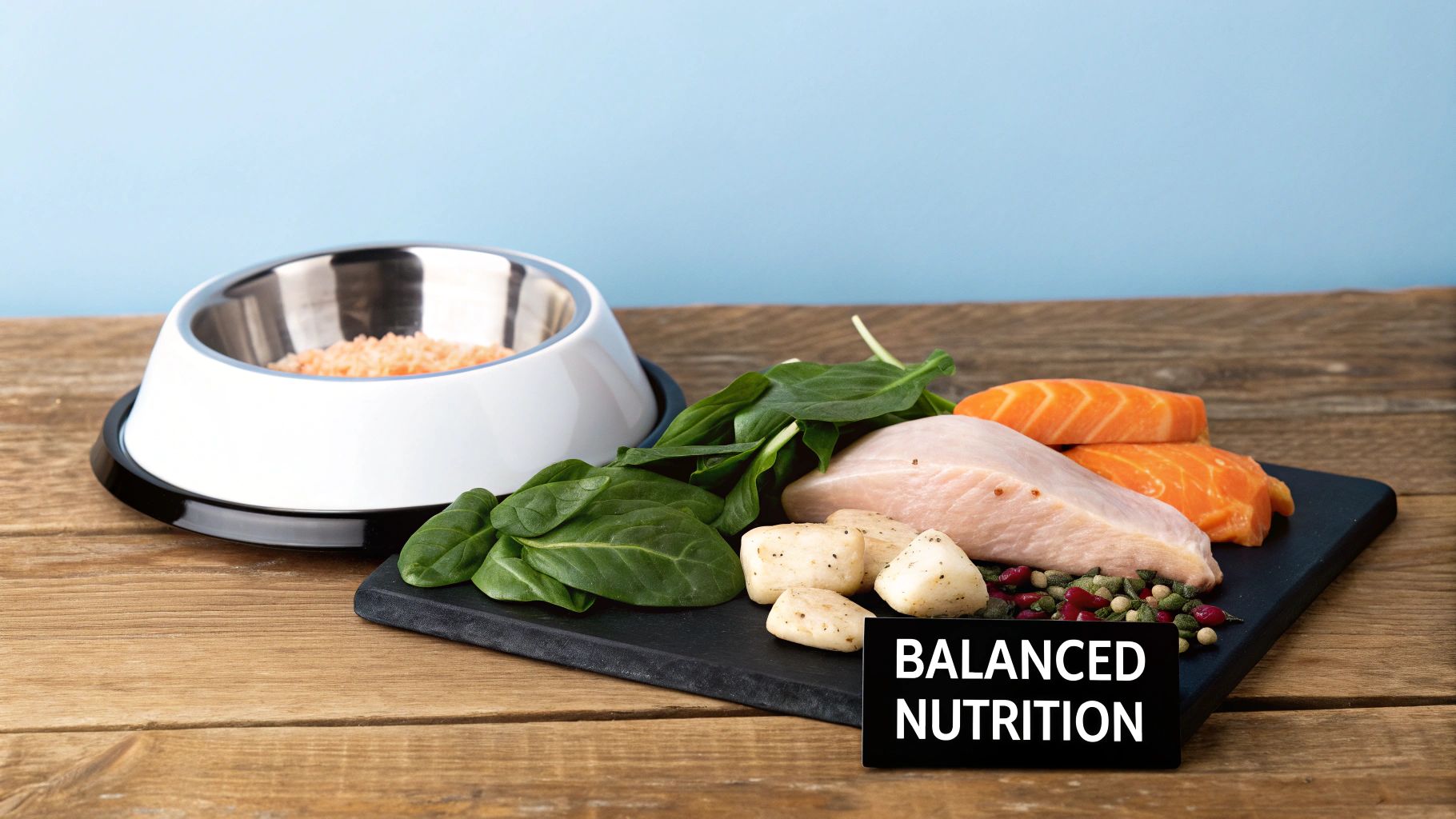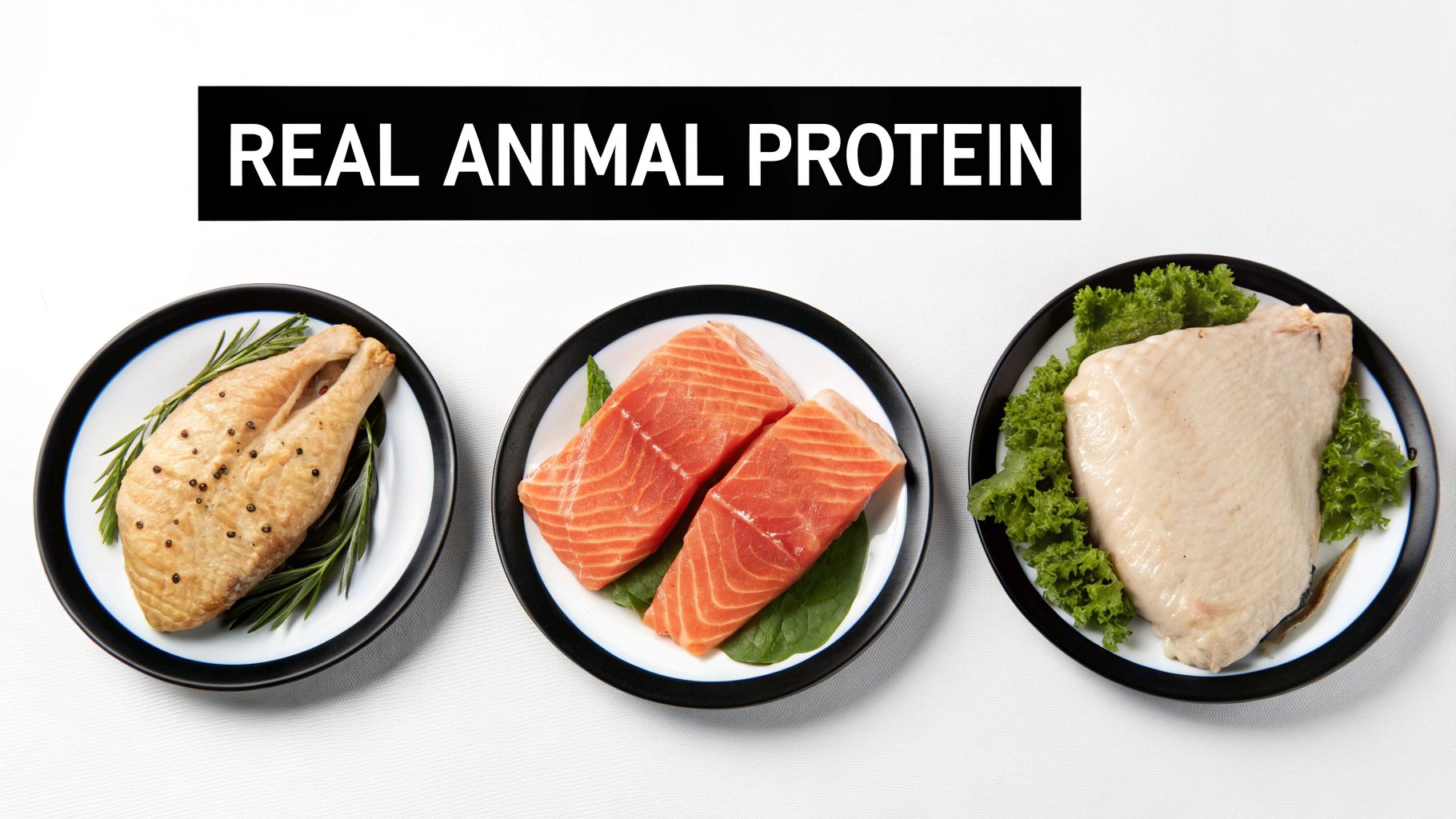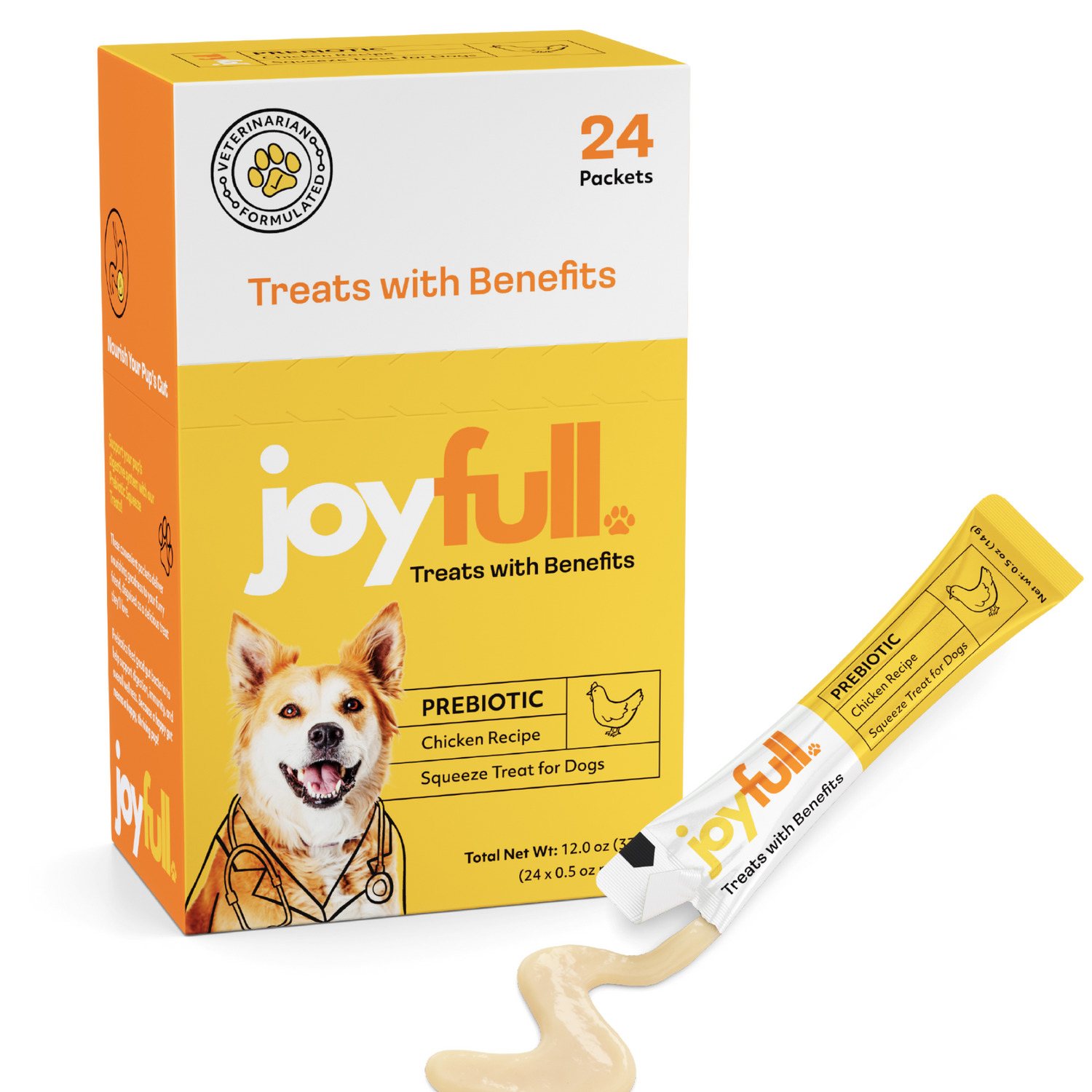
Good Ingredients for Dog Food Your Definitive Guide
So, what actually makes a good dog food? It’s not about flashy packaging or a fancy name on the bag. The best diets are built from the ground up with high-quality, digestible proteins, healthy fats, and the right kind of carbs that a dog's system can put to good use.
What Makes Dog Food Truly Good

Walking down the pet food aisle can feel like a pop quiz you didn't study for. With so many brands making big promises, how do you sort through the noise? It all comes down to a single, powerful concept: bioavailability.
Think of it this way. A stack of high-quality lumber has the potential to become a sturdy house, but only if a builder can actually cut, shape, and assemble it. If the wood is warped or inaccessible, it’s just a pile. The same goes for dog food. Ingredients are only valuable if your dog’s body can easily break them down, absorb the nutrients, and use them. That's bioavailability in a nutshell.
Low-quality ingredients might check the right boxes on paper, but if they aren't bioavailable, they pass right through your dog's system without delivering much benefit. Truly good ingredients for dog food are chosen because they are absorbed and put to work efficiently.
The Core Nutritional Building Blocks
At its heart, a great dog food formula is pretty simple. Once you understand the core components, you’ll be able to read any label with confidence.
Let's break down the essential building blocks that should be in every bowl.
Core Components of a Healthy Dog Food
| Ingredient Category | Primary Role | Examples of Good Sources |
|---|---|---|
| High-Quality Proteins | Builds and repairs muscle, supports the immune system, and provides essential amino acids. | Real chicken, salmon, beef, lamb, and eggs. |
| Beneficial Fats | A concentrated energy source. Omega fatty acids support brain health, reduce inflammation, and promote a shiny coat. | Fish oil (from salmon or pollock), flaxseed, and chicken fat. |
| Nutrient-Dense Carbs | Provides sustained energy and dietary fiber, which is crucial for good digestion. | Sweet potatoes, brown rice, peas, barley, and oats. |
These are the pillars of a diet that doesn't just fill your dog's stomach but actively nourishes their body from the inside out.
Focusing on nutrient quality isn't just a fleeting trend—it's a fundamental shift in how we care for our pets. More and more, owners are scrutinizing what goes into their dogs' bowls, and the market reflects that. Projections show the dog food and snacks industry growing from USD 2.8 billion in 2025 to USD 4.4 billion by 2035.
This surge shows a clear demand for premium nutrition. You can explore more about this growing market trend to see just how much pet wellness is becoming a priority for owners everywhere.
Decoding Proteins: The Building Blocks of Health

When you flip over a bag of dog food, the very first ingredient you should scan for is a high-quality protein. It’s the cornerstone of your dog’s health, responsible for building everything from strong muscles and a shiny coat to a resilient immune system.
Think of protein as a LEGO set. The individual bricks are amino acids, and your dog needs them to build and repair just about everything in their body. Dogs need a total of 22 different amino acids to function, but their bodies can only make 12 of them on their own.
The other 10 are called essential amino acids, and they absolutely must come from food. This is precisely why the quality of the protein source in their bowl is so incredibly important.
Animal Proteins vs. Plant Proteins
This is where things get interesting. Animal-based proteins—like chicken, beef, fish, and lamb—are what we call "complete" proteins. They come pre-packaged with all 10 essential amino acids in the perfect ratios for your dog to absorb and put to work immediately.
On the other hand, you have plant-based proteins from sources like corn or soy. While they're not necessarily "bad," they are often incomplete, meaning they’re missing one or more of those essential amino acid bricks. A diet built primarily on these requires very careful formulation to fill in the nutritional gaps.
The gold standard for most dogs is a diet where a named animal protein is the first ingredient. This ensures they are getting a complete and easily digestible foundation for their health.
This isn't just a hunch; it's a driving force in the pet food world. Industry analysis projects that animal proteins will make up about 22.7% of the global ingredient market share in 2025. That’s a huge testament to how critical they are for top-tier dog food.
Identifying High-Quality Proteins on the Label
Knowing what to look for is half the battle. When you’re in the pet food aisle, your mission is to find specific, identifiable protein sources.
Here’s a quick cheat sheet for reading that label:
- Green Flags: You want to see specific names like "deboned chicken," "lamb," "salmon," or "beef." These are clear and transparent. Terms like "chicken meal" or "lamb meal" are also great—a "meal" is just the meat with most of the water removed, making it a super-concentrated source of protein.
- Red Flags: Watch out for vague, generic descriptions. Phrases like "meat by-products," "animal digest," or "meat and bone meal" are huge red flags. They don't tell you which animal the protein came from, and the quality can be wildly inconsistent.
Choosing a food with a named protein like salmon gives your dog more than just amino acids; it also delivers healthy omega-3 fatty acids for their skin and coat. To really get into the weeds, you can explore the best protein sources for dogs in our detailed guide. At the end of the day, a clear, high-quality protein at the top of the list is the first and best sign of a well-made dog food.
Choosing the Right Fats and Carbohydrates
Just like proteins, not all fats and carbs are the same. These aren't just empty fillers tossed in to bulk up the kibble; they are the primary fuel that powers everything from your dog's daily zoomies to their sharp mind and shiny coat. Getting this part of their diet right is a game-changer for their long-term health.
Think of fats as the most concentrated energy source in the bag. A dog's body needs high-quality fats to absorb certain vitamins, regulate its temperature, and cushion its vital organs. They're like the slow-burning logs on a fire, providing steady, consistent energy all day long.
But it’s the kind of fat that really makes the difference.
The Power of Omega Fatty Acids
You’ve probably heard people talk about omega fatty acids, and for good reason. These are special polyunsaturated fats, particularly omega-3 and omega-6, that are absolute powerhouses for a dog's health. The key is finding a food that strikes the right balance between the two to help manage inflammation and keep your dog feeling their best.
When you're scanning an ingredient list, keep an eye out for these fantastic fat sources:
- Fish Oil: Usually from salmon, pollock, or sardines, this is the gold standard for omega-3s (specifically EPA and DHA). These are famous for promoting healthy skin, a glossy coat, and supporting brain and joint function.
- Flaxseed: This is a great plant-based source of omega-3s that also brings a healthy dose of fiber to the table, which is a big win for digestion.
- Chicken Fat: Don't let the name put you off! As long as it's preserved naturally, this is an excellent source of omega-6 fatty acids, which are essential for normal growth and a strong immune system.
These are some of the best good ingredients for dog food because they pull double duty, delivering both raw energy and targeted health benefits.
Think of healthy fats as the lubricant for your dog's biological engine. They reduce friction in the joints, keep the skin supple, and help the brain’s cognitive gears turn smoothly.
Smart Carbohydrates for Sustained Energy
Carbohydrates have developed a bit of a complicated reputation, thanks in large part to the whole "grain-free" marketing boom. The truth is, the problem was never grains themselves, but the quality of the carbohydrate source. The goal is to give your dog sustained energy, not a quick sugar high followed by an inevitable crash. If you're curious, our guide on whether grain-free dog food is better really digs into this topic.
Complex carbohydrates are what you should be looking for. These are digested slowly, providing a steady stream of glucose into the bloodstream. This means consistent energy and plenty of dietary fiber to keep their digestive system humming along. Simple carbs, like cheap corn or wheat fillers, can spike blood sugar and don't offer much else nutritionally.
Here are a few high-quality, complex carbs to look for:
- Sweet Potatoes: They're loaded with vitamins, minerals, and fiber.
- Peas and Lentils: These are excellent sources of energy that also provide some protein and fiber.
- Brown Rice and Oats: For most dogs, these wholesome grains are easy to digest and offer fantastic, long-lasting fuel.
By choosing a food with these kinds of smart energy sources, you’re making sure your dog has the fuel they need to truly thrive.
Why Micronutrients Are a Big Deal
If protein is the lumber and fat is the fuel, think of vitamins and minerals as the spark plugs that fire up your dog’s entire biological engine. These micronutrients might be needed in smaller amounts, but they are the unsung heroes of truly exceptional dog food.
They’re the catalysts for just about everything, from converting food into energy to building a rock-solid immune system. Without them, even the best proteins and fats can’t do their jobs properly. It's like having a top-tier construction crew with the best materials but no nails or screws—micronutrients are the fasteners holding it all together.
The Power of Whole Foods
You'll notice many dog foods add a synthetic vitamin and mineral mix to meet nutritional standards, and that's okay. But the really great formulas often get these micronutrients directly from whole food sources. This is one of the clearest signs you've found a premium product.
So, why does this matter? Whole foods like blueberries, carrots, and spinach deliver vitamins and antioxidants in their natural, complex state. This often makes them more bioavailable, which is just a fancy way of saying your dog's body can recognize and absorb them more easily than their isolated, synthetic counterparts.
- Antioxidants (like Vitamin E): Found in ingredients like blueberries and cranberries, these powerful little compounds help protect your dog's cells from damage. They're vital for a strong immune system and promoting overall health, especially as your dog ages.
- Calcium and Phosphorus: These two minerals are a team, working together to build and maintain strong bones and teeth. A quality food ensures they're present in the right ratio for your dog to actually absorb and use them effectively.
When you spot whole food ingredients like sweet potatoes, kelp, or kale on a dog food label, it's a fantastic sign. It tells you the manufacturer is committed to delivering nutrients the way nature intended, which is a hallmark of a top-quality diet.
A Pro Tip: Look for Chelated Minerals
As you get better at reading labels, keep an eye out for the term chelated minerals. It sounds technical, but the concept is simple and it’s a huge indicator of quality. Chelation is just a process where a mineral, like zinc or iron, is bonded to an amino acid.
This bond makes a massive difference. It essentially shields the mineral on its journey through the digestive tract, making it much easier for your dog’s body to absorb. Non-chelated minerals often struggle to be absorbed and can end up being passed as waste. Seeing "zinc proteinate" instead of "zinc oxide" is a small detail that speaks volumes about the thought put into the formula.
How to Read a Dog Food Label Like an Expert
Knowing what makes for a quality dog food is one thing, but actually spotting it on a crowded store shelf? That's a completely different challenge. This is where a little know-how turns you into a savvy shopper. A dog food label can look like it's written in a secret code, but once you learn to recognize a few key things, you'll be able to decipher any bag with confidence.
The ingredient list is always your first stop. By law, ingredients are listed by weight, from heaviest to lightest. This means the first handful of items make up the vast majority of what’s in the bag. That’s why one simple trick is so incredibly effective.
Master the First Five Rule
Zero in on the first five ingredients. This is your snapshot of the food's quality and nutritional backbone. What you want to see is a high-quality, clearly named animal protein sitting at the top of the list—think "deboned chicken" or "salmon," not "meat meal."
Ideally, that top protein is followed by other whole foods like nutrient-rich carbs, healthy fats, or even another protein source. If the first five ingredients are a jumble of vague terms, cheap fillers like corn gluten meal, or chemical-sounding preservatives, it’s a huge red flag. Just put the bag down and walk away. This quick check cuts right through the flashy marketing and tells you what you're really feeding your dog.
Decoding the Guaranteed Analysis
Next up, you'll find the Guaranteed Analysis panel. This box gives you the bare-bones nutritional stats: the minimum percentages of crude protein and fat, and the maximum percentages of crude fiber and moisture.
But here’s the catch: this panel doesn't tell you the whole story. A food with 25% protein sounds good, but it doesn't reveal anything about that protein's quality or how easily your dog can digest it. A brand could hit that number using premium salmon or, on the flip side, low-grade feather meal. That's precisely why you have to use the Guaranteed Analysis together with the ingredient list. For a deeper dive, our guide on how to read dog food labels breaks it all down.
Green Flags vs Red Flags on the Ingredient List
To make it even simpler, here's a quick cheat sheet. When you're scanning that ingredient list, you're essentially looking for green flags while trying to avoid the red ones.
| Look For These (Green Flags) | Avoid These (Red Flags) |
|---|---|
| Whole, named proteins (e.g., deboned chicken, beef, salmon) | Vague "meat" or "poultry" by-products |
| Whole grains (e.g., brown rice, oatmeal, quinoa) | Fillers like corn gluten meal, wheat gluten, soy |
| Named animal fats (e.g., chicken fat, salmon oil) | Unspecified "animal fat" |
| Fruits and vegetables (e.g., sweet potatoes, carrots, blueberries) | Artificial colors (e.g., Red 40, Yellow 5) |
| Natural preservatives (e.g., mixed tocopherols, vitamin E) | Chemical preservatives (e.g., BHA, BHT, ethoxyquin) |
Think of this table as your at-a-glance guide. The more ingredients you see from the "Green Flags" column, especially in those first five spots, the better.
The AAFCO Statement Your Seal of Approval
Finally, hunt for a small but critical statement from the Association of American Feed Control Officials (AAFCO). AAFCO isn't a government agency, but it's the organization that sets the nutritional standards for pet foods in the U.S.
The AAFCO statement is your proof that the food is "complete and balanced" for a specific life stage, like puppy growth or adult maintenance. Without it, you have no real assurance that the food provides all the essential nutrients your dog needs to thrive. It's a non-negotiable checkpoint for any food you're seriously considering.
This infographic really drives home how the good stuff you find on the label translates into real health benefits for your dog.

As you can see, quality ingredients aren't just about fancy marketing—they are the direct building blocks for strong bones, a healthy coat, and a robust immune system. By applying the "first five" rule and always checking for that AAFCO statement, you can be confident you’re choosing a food that truly nourishes your best friend.
We Answer Your Most Common Questions About Dog Food Ingredients
Even when you know the difference between a protein and a carb, the world of dog food can still leave you scratching your head. It's totally normal. A few specific questions always seem to come up, so let's clear the air and tackle them head-on.
As you get into the weeds of choosing ingredients, it's also a good idea to bust some of the common nutrition myths regarding pet food. Knowing fact from fiction makes every other decision that much easier.
Let's dive into the questions I hear most often from fellow dog owners.
Are Grain-Free Diets Really Better for Dogs?
Not always. The grain-free trend was a marketing tidal wave, but the reality is a lot more complicated. For the small handful of dogs that have a genuine grain allergy, a grain-free diet is a lifesaver. For most dogs, though? High-quality whole grains are perfectly healthy.
The real conversation shouldn't be about getting rid of grains, but about the quality of the carbs you're including.
- The Good Grains: Ingredients like brown rice, quinoa, and oats are fantastic. They’re complex carbs that deliver steady energy, fiber, and B vitamins.
- The Real Problem: The issue was never good grains. It was cheap, low-nutrient fillers like corn gluten meal or wheat gluten that offer next to no nutritional value.
A well-made food with healthy whole grains is almost always better than a poorly made grain-free food packed with cheap potato or pea protein. It’s about the whole picture, not just one ingredient category.
When in doubt, a quick chat with your vet is the best way to figure out if your dog actually needs to go grain-free.
What’s the Difference Between "Chicken" and "Chicken Meal"?
This is probably one of the most common points of confusion on an ingredient label, but the answer is pretty simple once you understand how ingredients are weighed. It all comes down to water.
Chicken: This term refers to whole, fresh chicken meat. Because it’s listed in its natural state, it’s mostly water—we’re talking 70-80%. It’s a great ingredient, but a lot of its weight disappears during cooking.
Chicken Meal: This is what you get after the chicken has been rendered. In this process, the water and fat are cooked out, leaving behind a super-concentrated protein powder.
So, which is better? Honestly, a great food will often have both. Fresh chicken adds flavor and high-quality nutrients, while a named "meal" (like chicken meal or salmon meal) packs a serious protein punch in the final kibble. Seeing "chicken meal" high on the list is actually a good sign—it means more protein by weight.
Should I Bother Looking for Foods with Glucosamine or Probiotics?
Absolutely! These are what we call functional ingredients—they’re added to provide a specific health benefit that goes beyond basic nutrition. Spotting them on a label is often a tell-tale sign of a premium, well-thought-out food.
Think of them as bonus features that are there to help your dog thrive, not just survive.
- Glucosamine: This is a natural compound that helps maintain healthy cartilage in the joints. It’s especially great for big dogs, seniors, and active pups who put a lot of mileage on their joints.
- Probiotics: These are the "good bugs." They're live, beneficial bacteria that support a healthy gut. A happy gut is key for good digestion and a strong immune system, since a huge part of a dog's immunity is housed right there in their digestive tract.
While AAFCO doesn't require these ingredients for a food to be "complete and balanced," their presence shows that a brand is going the extra mile. It’s a definite green flag.
At Joyfull, we believe in going that extra mile. Our formulas are crafted with high-quality proteins, beneficial nutrients, and functional ingredients to support your pet's total well-being, because a healthful life isn't just for humans. Explore our commitment to clean, science-backed pet nutrition at https://joyfullpet.com.

